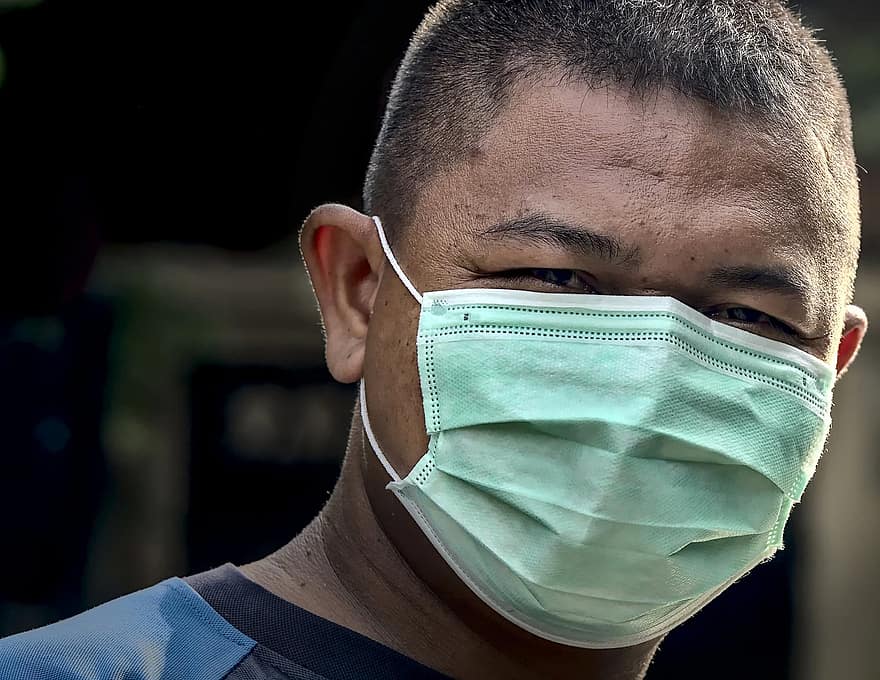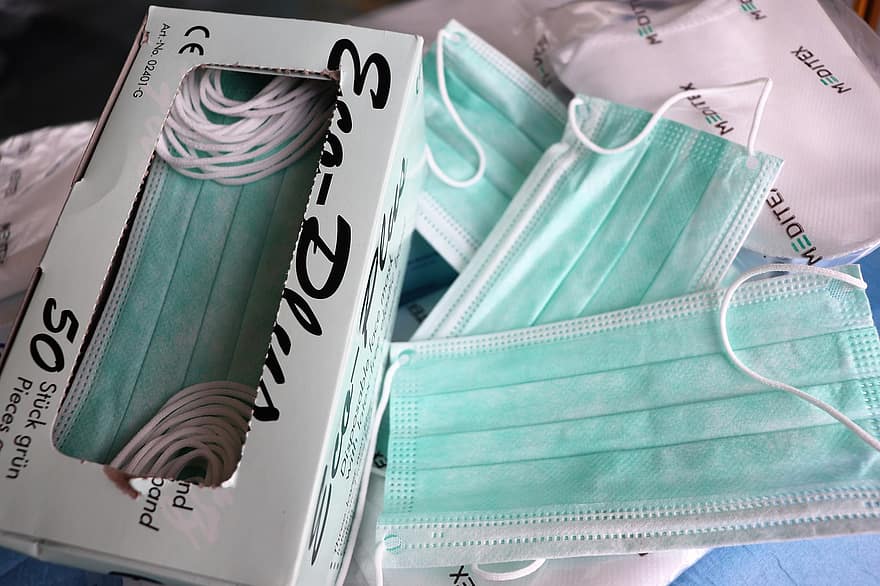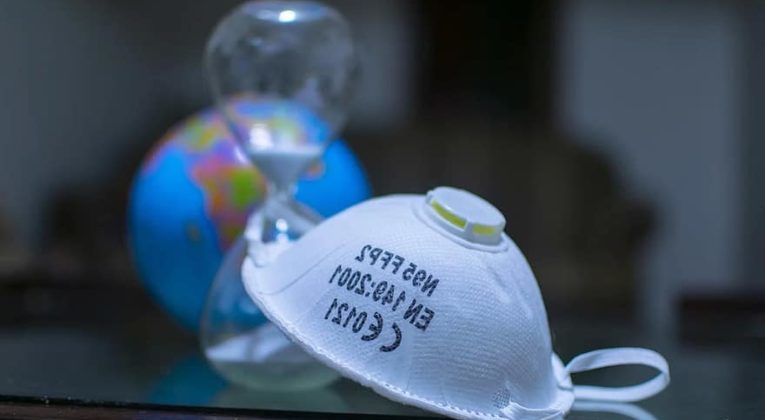Professor in microbiology, Hans Jørn Jepsen Kolmos, thinks that facial masks will be a solution to protect ourselves from the coronavirus on multiple segments of the journey. Just not on board the aircraft.
Throughout the past week, multiple airlines have announced that they will resume flying with a requirement for passengers to wear masks in-flight. But is that sensible? InsideFlyer has asked professor in microbiology at the University of Southern Denmark, Hans Jørn Jepsen Kolmos, to educate us on how we should protect ourselves against the coronavirus while flying.
How well does a mask protect?

Facial protection masks come in many variations, sizes and looks. Just as many answers exist too, on how well the masks protect us. More generally, it is, however, possible to conclude that the masks can be divided into three different groups. The three are fabric masks, surgical masks and N95 respirators. The fabric masks are the least effective and are generally not recommended to use for virus protection. After that come the surgical masks, which are for instance used to perform operations. These place themselves in the middle in terms of effectiveness and keeps parts of the infection/virus out. At the top, we find N95 respirators, which are the most effective masks. N95 respirators, however, also don’t keep (virus) infections completely away.
Surgical masks and N95 respirators are quite effective as long as they are dry. However neither surgical masks nor the respirators can guarantee with 100% certainty, that you won’t get infected yourself by wearing them. You are even still likely to transfer the disease/virus whilst wearing the mask. A surgical mask for instance lets one fourth of particles in the air pass, when inhaling, meaning that you reduce the risk of getting infected by 75%. When exhaling, up to half of the particles will pass. N95 respirators are more effective, and provides 95% protection from getting infected, while it lets 30% of the liquid in exhalation air pass.
Hans Jørn Jepsen Kolmos, professor in microbiology at University of Southern Denmark
Hans Jørn directly discourage the use of fabric masks, as their effect is not proven, and in the worst case, can expose you even more to the infection:
It is important to underline, that only surgical masks and certified respirators are effective. Fabric masks are more permeable for drops and particles, and one should therefore ensure that only masks of documented quality is used.
Hans Jørn Jepsen Kolmos, professor in microbiology at University of Southern Denmark
Are masks a false sense of security?

For that question, there is no short answer. Everything depends on the circumstances that you use the masks for. If the mask is used for short periods of time, and you disinfect your hands often, the mask can be helpful. The mask, however, also has to be used rationally and not just as a standardized habit/ritual.
Infections do not care about rituals, and masks are only helpful in situations with a high likelihood of being exposed to infections. Those could, for instance, be during boarding, while visiting the lavatory, or when leaving the aircraft. During the flight, the mask, however, can cause more damage than it helps.
Masks can be effective, if used at the right time, in the right way. The mask can however also provide a false sense of security, if used without rationale. A mask is only effective as long as it’s dry. In our exhalation air there is moisture, and it varies for how long the masks will be effective. It’s however estimated that a mask will not be effective for more than a couple of hours.
Hans Jørn Jepsen Kolmos, professor in micro biology at University og Southern Denmark
Masks do not only lose their protective properties by getting wet. Another way to bring down the protectiveness is when you touch the mask or your face. Doing that, bacterias can in even more ways find their way into your body:
When touching the mask – for instance when drinking coffee, repositioning it, etcetera – you can pollute your fingers with virus particals from the mask itself. That way, you neutralise the effect of the mask, in the best case scenario. Therefore masks cant be the only protective equipment used and should be limited to rationally selected tasks and timeframes.
Hans Jørn Jepsen Kolmos, professor in microbiology at University of Southern Denmark
How should airlines protect passengers?

Hans Jørn has a suggestion on when masks could be relevant during travelling. He believes that, for instance, it could be helpful to use masks when initiating boarding, or when passengers leave the aircraft. However, he points out, that hand sanitiser is the most important factor, in protecting passengers from getting infected by COVID-19.
It’s imaginable that airlines would distribute masks prior to boarding. Passengers could then wear the masks during boarding, and remove them when they are seated. When the plane has landed, maskes could then again be distributed, for the passengers to wear, until they have claimed their luggage.
The most important precaution based on my knowledge, is hand sanitiser. It is important that passengers disinfect their hands, after touching their faces, especially after touching the mask. At the samt time it is important, that passengers disinfect their hands, before eating or drinking anything. A proper disinfection of hands takes 20-30 seconds, and you should use an amount of sanitiser that equals it taking 20-30 seconds to rub in to the fingers, so that the skin feels dry.
Hans Jørn Jepsen Kolmos, professor in microbiology at University of Southern Denmark
InsideFlyer’s suggestions for Corona-proof air travel

Based on Hans Jørn Jepsen Kolmos’ insights, the InsideFlyer team has made a list with five suggestions, to make air travel safer:
- Masks at boarding: Distribute certified masks to passengers, and make sure that there is hand sanitiser available at the gate. Passengers should furthermore be instructed to remove the mask, once taxiing to the runway.
- Hand sanitiser in sufficient amounts: Make sure that hand sanitiser is available during the flight, and is regularly distributed by the cabin crew. At the same time, make sure that passengers are instructed in disinfecting their hands in a proper manner. Include this in the safety instructions before
- Limited mobility: Moving around in the cabin should not be allowed unless the passenger is going to the lavatory. When visiting the lavatory, cabin crew should be contacted, and instruct the passenger to use a specific lavatory, so waiting lines don’t form. Masks and hand sanitiser could be given to the passenger at this point.
- Smart boarding procedure: Boarding should be executed in order of passengers seating. One suggestion could be to board from the window seats towards the aisle so that the passengers won’t be trapped closely in the aisle during boarding.
- Smart disembarking procedure: A new mask should be distributed to passengers just before arrival, and they should be instructed to leave the plane in a manner so that waiting lines don’t form. This will be time-consuming but is very important. Cabin Crew can, for instance, guide the passengers on when to leave their seat.
Who is the expert?

Hans Jørn Jepsen Kolmos is a professor in microbiology at the University of Southern Denmark. Hans Jørn got his PhD in medicine in 1974, and in 1986 acquired his title as a specialist in microbiology. Since then, he has become a professor in the same field and especially works with infection control and infection prevention.
All pictures from Pikist



It seems that this article misses a major aspect of cloth masks, which is to protect those around you by trapping the wearer’s saliva droplets so that they don’t hover in air vs. protecting yourself. This is very relevant if all passengers and attendants are wearing them as would be the case here.
Another part of it would just be that cloth masks are by far more comfortable to wear long term compared to an N/KN 95 mask which can be difficult to breathe through because of the filter. If everyone had one that provided that protection for their own exhales and sneezes that was also easy to talk in and not uncomfortable I think it’s silly not to require them.
Not to mention that mandatory masks provide double the protection since particles need to go through both.
Anyway… just think there is definitely an argument to be made for them.
Are N-95 masks effective if they have been washed and dried thoroughly?
The mask thing is just like the TSA – theatre to make people feel safer. Little benefit, huge down-sides, and no value at all. Especially once they get moist.
Thanks to INSIDEFLYER for pressing more confusing miss information. The CDC recommends it, the airlines require it, so why even question something that could possibly save your life? I live with a PhD in cell molecular biology and while I don’t Question your experts opinion, I bet you can find a researcher out there that says that it’s OK to lick the seat back table in order to acquire immunity to the virus. The facts are already in front of us. Washing your hands offers the greatest protection and second to that we have the use of mass which offer another percentage of protection. I do think this was a disservice to the flying public to even challenge the science we already know.
You response is well written and as a biological chemist I agree entirely! This article is a disservice by giving people more of an incentive for not wearing masks.
All of you PHDs have forgotten the most important defense is an offense. Where is the public health info from the immune system experts telling us if risk factors (such as low vitamin D levels, obesity and metabolic syndrome) are mitigated and immune systems boosted, virus exposure will not matter? Strong immune systems are far better at protecting the host and preventing transmission.
Why is this not in the news?
I believe (or at least hope) the expert is assuming there is eating and drinking taking place. I’d agree wearing a mask while dining would probably increase the likelihood of cross-contamination from lowering and raising a mask. I, however, would not be comfortable in any public place sans masks requirements other than dining.
Denmark economy collapsed as a result of coronavirus pandemic, but the fact that is it down below the EU average and the death rate is quite low, shows us the importance of the accurate measures. They took the accurate measures and now stopped the virus, rescuing the economy and business. Good job, Denmark!
So if I’m in Las Vegas and I have a 95% chance of winning how much should I put on that bet?
Everyone is concerned about comfort, but this is not the issue. It will be uncomfortable to wear a mask for as many as 5 -6 hours at a time without removing it if you have a coast to coast plane flight. Cloth masks and even N95/P95 masks that do not provide a tight seal around your mouth and nose will allow air to come in from other directions, such as the sides and the top. If someone should sneeze or cough in these kinds of masks there will be leakage around the sides allowing potential contagion to escape into the surrounding environment. Only masks that provide an air-tight seal around the mouth and nose and also have a very high filter percentage such as P95 or P100 (95% or 99.97% of airborne particles respectively) will give a person the best chance of making it through a flight with protection, and as it is not completely fool proof there is no way to guarantee complete protection. This kind of mask is not comfortable, they are respirators with removable filters, as that is the only kind that gives the necessary seal around your mouth and nose. This is the cost for traveling more safely.
To avoid any chance of cross-contamination or other exposure to the air in the cabin, the mask should be placed on your face only once, without further adjustment or removal until you are safely out of danger, which means out of the airport entirely. If the mask is touched in flight, your hands will then be contaminated and must be cleaned at once. The minute the mask is lifted off the face and the seal is broken, there will be an unavoidable change of exposure with no filter at all. In this case it pays to be completely vigilant, don’t touch the mask or your face.
Other ways to enhance protection are to wear eye protection such as safety goggles or ski goggles. There is some evidence that the virus can enter the body via the eyes so protecting them is also important. using a clear visor is also a good idea on a plane, it will give you another layer of protection, especially when seated with the air vent pointed straight down to aim just in front of the visor. This positioning will create a bit of air turbulence that will direct anything that might be projected at some force into the air (such as a sneeze or a cough) that will help to carry any potential contagion away from your mask.
It goes without saying that you need to clean all surfaces in the row and the seat you are sitting in, including the wall and window, and if going to the bathroom it would be a good idea to wipe that down as well before touching anything, or wear gloves and then dispose of them safely when you get back to your seat by sealing them in a zip lock bag.
The problem with traveling by air can be boiled down to two parameters: duration and proximity. If you are forced to sit within 6 feet of another person for whom you have no knowledge of their ability to expose you to the virus, you do not have a choice. Since most flights are booking every row with window and aisle seats leaving the seat in the middle open, in nearly every case you will be potentially exposed to as many as 11 people in your 6 foot vicinity. If you are fortunate to have a row empty behind or in front of you there are fewer people, and it you are traveling with a partner you can occupy an entire row which means at least in your row you will not have to worry about that other person. It is also well known that the safer seat in this pandemic situation is the window seat, as it is the farthest away from the aisle where people will be moving back and forth to the bathroom. The shorter the flight, the less chance of loading up on any potential viral load. The longer the trip the higher exposure time and the more possibility of exposure. It’s a tough choice, while there is no evidence that airplane travel is causing an increase in cases, there have been some reported cases of groups of people who were exposed together all getting the disease, but this was likely before masks have become required.
There is a much simpler solution than the novel you just wrote…….if you have a comorbidity, don’t fly. Everyone really needs to stop living in fear. It must be a terrible way to live.
Serious question. People won’t stop talking about surface decontamination and hand washing. Can someone provide evidence that spreading is happening at a non-negligible level via surface contact (please don’t bother citing a single example; statistical data only)? If not, can we please stop with the hand washing nonsense? Hand washing should be placed in the same file as seatbelt wearing. Both are great things to do, but have nothing to do with CoronaVirus. CoronaVirus spreads via inhaled air droplets – full stop.
Theories are like…well, everyone has one. The Danish professor believes it’s better to sit in the tight quarters of an
aircraft without a mask. Good for him, and I wish him health and good luck. If i were to resume flying, and that’s unlikely
until we learn a lot more about this virus, I’d stick with a mask. We KNOW they work better than not. It is also important to
remember that at least 45% of all Covid-19 carriers are asymptomatic so while you are sitting on that plane, surrounded
by others without masks, half of your fellow fliers could infect YOU. Thanks, Professor, but no thanks. Are you sure you’re not a Trump University graduate?????